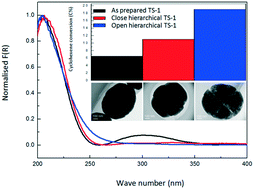当前位置:
X-MOL 学术
›
Catal. Sci. Technol.
›
论文详情
Our official English website, www.x-mol.net, welcomes your
feedback! (Note: you will need to create a separate account there.)
Inter-connected and open pore hierarchical TS-1 with controlled framework titanium for catalytic cyclohexene epoxidation†
Catalysis Science & Technology ( IF 4.4 ) Pub Date : 2018-03-29 00:00:00 , DOI: 10.1039/c7cy02571h Yilai Jiao 1, 2, 3, 4, 5 , Abdul-Lateef Adedigba 1, 2, 3, 4, 5 , Qian He 1, 2, 3, 4, 5 , Peter Miedziak 1, 2, 3, 4, 5 , Gemma Brett 1, 2, 3, 4, 5 , Nicholas F. Dummer 1, 2, 3, 4, 5 , Micheal Perdjon 1, 2, 3, 4, 5 , Jinmin Liu 6, 7, 8, 9, 10 , Graham J. Hutchings 1, 2, 3, 4, 5
Catalysis Science & Technology ( IF 4.4 ) Pub Date : 2018-03-29 00:00:00 , DOI: 10.1039/c7cy02571h Yilai Jiao 1, 2, 3, 4, 5 , Abdul-Lateef Adedigba 1, 2, 3, 4, 5 , Qian He 1, 2, 3, 4, 5 , Peter Miedziak 1, 2, 3, 4, 5 , Gemma Brett 1, 2, 3, 4, 5 , Nicholas F. Dummer 1, 2, 3, 4, 5 , Micheal Perdjon 1, 2, 3, 4, 5 , Jinmin Liu 6, 7, 8, 9, 10 , Graham J. Hutchings 1, 2, 3, 4, 5
Affiliation

|
A post-synthesis method was developed to reduce the extra-framework titanium (Ti) in TS-1 zeolites (Si/Ti ratio = 50), in which tetrapropylamonium hydroxide (TPAOH) aqueous solution was used to promote the dissolution, redistribution and recrystallization processes, and hence to convert amorphous Ti species into zeolitic phases. It was found that TPAOH could effectively convert the extra-framework Ti into framework Ti, and the TPAOH concentration influenced the pore structure significantly. Under lower TPAOH concentration (i.e. 0.05–0.4 M), only closed meso-/macropores (grooves and hollow cavities) can be created in the TS-1 crystals. At an optimum concentration of 0.5 M TPAOH, open and connected hierarchical mesopores and macropores were created in the resulting TS-1 zeolites. Compared with the parent TS-1, the amount of extra-framework titanium was reduced significantly from 14.4% to 0.3% and the meso-/macropore volume was increased from 0.014 to 0.168 cm3 g−1 accordingly upon TPAOH post treatment. Along with the parent TS-1 zeolite, the developed hierarchical TS-1 zeolites were assessed in the catalytic epoxidation of cyclohexene. It was confirmed that the amount of framework titanium and hierarchical pore structure influenced the catalytic activity considerably. Closed porosity slightly improved the cyclohexene conversion, whereas the open-pore sample shows the optimum catalytic activity in cyclohexene conversion.
中文翻译:

相互连接的开孔分层TS-1和可控制的框架钛,可催化环己烯环氧化†
开发了一种后合成方法以减少TS-1沸石(Si / Ti比= 50)中的骨架外钛(Ti),其中使用氢氧化四丙铵(TPAOH)水溶液促进溶解,重新分布和重结晶过程,从而将无定形的Ti物种转化为沸石相。发现TPAOH可以有效地将骨架外的Ti转化为骨架Ti,而TPAOH的浓度对孔隙结构有显着影响。在较低的TPAOH浓度下(即0.05–0.4 M),在TS-1晶体中只能形成封闭的介孔/大孔(凹槽和中空腔)。在0.5 M TPAOH的最佳浓度下,在所得TS-1沸石中形成了开放的和连接的分级中孔和大孔。与母体TS-1相比,框架外钛的含量从14.4%显着降低至0.3%,中/大孔体积从0.014 cm增加至0.168 cm 3 g -1因此,在TPAOH后处理中。与母体TS-1沸石一起,在环己烯的催化环氧化中评估了已开发的分级TS-1沸石。证实了骨架钛的数量和分层孔结构对催化活性的影响很大。封闭的孔隙率略微改善了环己烯的转化率,而开孔样品显示出在环己烯转化中的最佳催化活性。
更新日期:2018-03-29
中文翻译:

相互连接的开孔分层TS-1和可控制的框架钛,可催化环己烯环氧化†
开发了一种后合成方法以减少TS-1沸石(Si / Ti比= 50)中的骨架外钛(Ti),其中使用氢氧化四丙铵(TPAOH)水溶液促进溶解,重新分布和重结晶过程,从而将无定形的Ti物种转化为沸石相。发现TPAOH可以有效地将骨架外的Ti转化为骨架Ti,而TPAOH的浓度对孔隙结构有显着影响。在较低的TPAOH浓度下(即0.05–0.4 M),在TS-1晶体中只能形成封闭的介孔/大孔(凹槽和中空腔)。在0.5 M TPAOH的最佳浓度下,在所得TS-1沸石中形成了开放的和连接的分级中孔和大孔。与母体TS-1相比,框架外钛的含量从14.4%显着降低至0.3%,中/大孔体积从0.014 cm增加至0.168 cm 3 g -1因此,在TPAOH后处理中。与母体TS-1沸石一起,在环己烯的催化环氧化中评估了已开发的分级TS-1沸石。证实了骨架钛的数量和分层孔结构对催化活性的影响很大。封闭的孔隙率略微改善了环己烯的转化率,而开孔样品显示出在环己烯转化中的最佳催化活性。











































 京公网安备 11010802027423号
京公网安备 11010802027423号